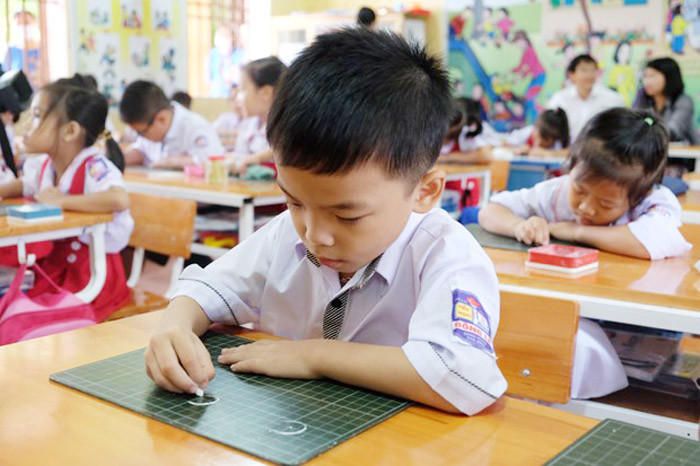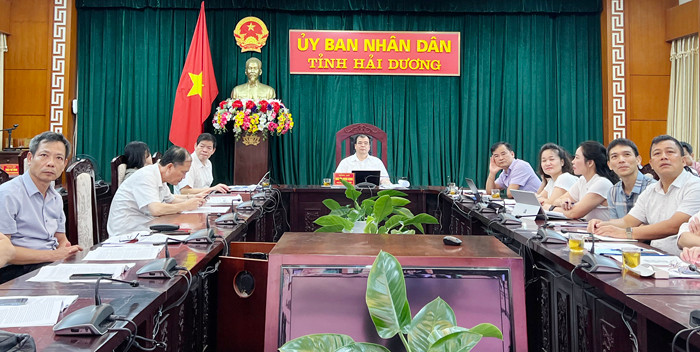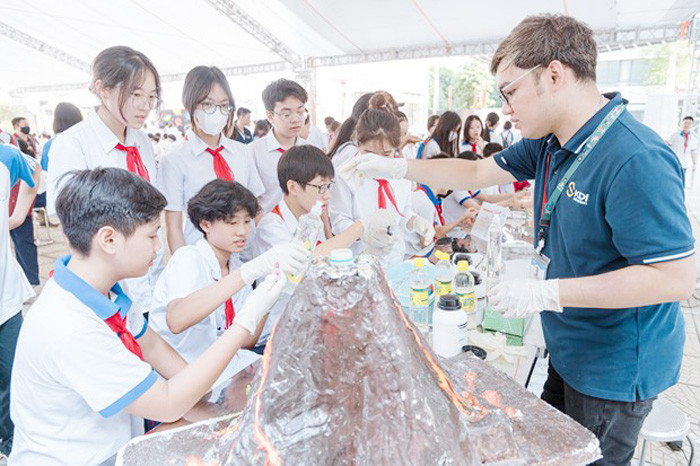In the 2022-2023 school year, the entire education sector has made efforts to overcome difficulties and challenges in human resources, facilities, new programs and achieved encouraging results.

In the 2022-2023 school year, the education sector has achieved many encouraging results.
Despite many difficulties such as lack of facilities and teachers while this is the first year of implementing the new general education program at all three levels at the same time, in the 2022-2023 school year, the entire education sector has made efforts and achieved many important results.
Attending the Hai Duong bridge were Vice Chairman of the Provincial People's Committee Nguyen Minh Hung and representatives of leaders of a number of departments, branches, and Departments of Education and Training of districts, towns, and cities.

Delegates attending at Hai Duong bridge point
Removing legal barriers
Reporting at the Conference on the summary of the 2022-2023 school year and the deployment of tasks for the 2023-2024 school year, the report of the Ministry of Education and Training said that in the past school year, the Ministry submitted and issued 56 legal documents under its authority. The legal documents were developed in the spirit of creating a legal environment to continue to fundamentally and comprehensively innovate education and training, gradually removing bottlenecks and obstacles arising from practice, creating an important legal corridor in state management of education and training, which is supported and agreed by the people.
The Ministry has completed the explanatory documents of the Law on Teachers and the Government has unanimously approved the necessity of promulgation and the policies expected to be included in the content of the Law on Teachers. The Ministry has also reviewed and systematized legal documents, announced documents under the Ministry's state management that will expire in 2022; abolished documents that are no longer appropriate.
In addition, the Ministry of Education and Training also frankly admitted that the drafting of some documents is still behind schedule, especially documents that have a great impact on the development orientation of the whole sector such as: Education Development Strategy to 2030, vision to 2045; Planning of the network of higher education and pedagogical institutions for the period 2021-2030, vision to 2050; Planning of the system of specialized educational institutions for people with disabilities and the system of centers supporting inclusive education. The sector is making efforts to complete and promulgate these documents.
Develop team, supplement facilities
Identifying the teaching staff as the core and key of the industry, in the 2022-2023 school year, the education and training sector has made continuous efforts to develop the team, especially in the context of a nationwide shortage of teachers.
The Ministry has also reviewed and surveyed the implementation of working regimes for general education teachers, the current status of policies for public preschool teachers, and from there proposed specific policies to improve the material and spiritual lives of teachers.
The Ministry has submitted to the Government and coordinated with the Ministry of Home Affairs to increase the number of teachers for the sector. By the end of the 2022-2023 school year, according to preliminary statistics based on industry data, the total number of preschool and general education teachers is over 1.2 million (an increase of nearly 72,000 compared to the 2021-2022 school year, of which public schools account for 88.57% and non-public schools account for 11.43%). The number of management staff increased by 100,135 (public schools account for 90.4% and non-public schools account for 9.6%).
The quality of the staff has also increased. In the last school year, the rate of teachers meeting the standards for preschool education was 86.3%, primary education was 83.3%, secondary education was 90.3%, and high school education was 99.9%.
The infrastructure of the sector has also been improved. The system of schools and classes continues to be planned and invested in to meet the learning needs of the people. According to statistics, the country currently has 37,619 public preschool and general education facilities, of which 12,152 are preschool schools, 12,354 are primary schools, 10,672 are secondary schools and 2,441 are high schools. Of these, the number of inter-level schools is 2,311.
Improve the quality of education
With the efforts of the whole industry, the quality of education in 2022-2023 has achieved encouraging results.
Preschool education has reduced thousands of separate schools, the rate of mobilizing children to go to school reached 70.4%, an increase of 4.6% compared to the previous school year. However, there are still some provinces with a very low mobilization rate compared to the national average.
At the general education level, the implementation of the 2018 General Education Program, especially for grades 3, 7 and 10 in the 2022-2023 school year, has initially achieved positive results.

Students of Hoang Mai Secondary School (Hoang Mai, Hanoi) experience STEM education
In the 2022-2023 school year, the rate of mobilizing students to attend primary school at the right age will reach 99.7%. The rate of mobilizing students completing the Primary Education Program to enter lower secondary school will reach 94.3%. The rate of students completing the lower secondary education program will reach 90.7%. Nationwide, 63/63 provinces and cities (100%) maintain and meet the standards for universal primary education, of which 30/63 provinces and cities (113) (47.6%) meet the standards for universal primary education level 3 (an increase of 4 provinces compared to the previous year); 11 provinces/cities (17.5%) meet the standards for universal lower secondary education level 2; 7 provinces/cities (11.1%) meet the standards for universal lower secondary education level 3.
The results at the 2023 regional and international Olympic competitions achieved high achievements with 11 gold medals, 14 silver medals, 12 bronze medals and 5 certificates of merit.
Continuing education has increased by more than 1,000 centers in the past school year compared to the previous school year, meeting the needs of people for continuing education and lifelong learning.
Still many challenges
Besides the achieved results, the implementation of the 2022-2023 school year plan of the industry still has shortcomings and limitations.
The biggest difficulty and challenge facing the industry today is the shortage of teachers. According to preliminary statistics based on industry data, the country is currently short of 118,253 teachers, an increase of 11,308 compared to the 2021-2022 school year. Of which, preschool education increased by 7,887, primary education increased by 169, secondary education increased by 1,207, and high school education increased by 2,045.
The shortage of teachers is concentrated in the position of preschool teachers; lack of English and IT teachers for primary schools; and lack of Music and Fine Arts teachers for high schools when applying the 2018 General Education Program from the 2022-2023 school year. In the implementation of the new general education program, there is also confusion in arranging subject combinations in grade 10, and the issue of textbooks still has shortcomings.
Along with the lack of staff, there is still a shortage of schools, classes and pressure on enrollment at the beginning of the school year, especially in Hanoi and Ho Chi Minh City. In some localities, there are still temporary classrooms and classrooms; lack of functional rooms and minimum teaching equipment, affecting the quality of teaching and learning, especially when implementing the new Program.
At preschool level, ensuring safety for preschool children in independent and private preschools, especially in urban areas, industrial parks, and export processing zones, is still limited.
Continuing education is still limited; the rate of mobilizing learners to eliminate illiteracy in border areas, areas with large ethnic minorities, and areas with difficult economic and social conditions is still low, and the results of eliminating illiteracy are not sustainable.
The work of educating children and students in ethics, lifestyle, and life skills; the work of supporting, providing psychological counseling, and skills to prevent and combat violence and child and student abuse are not really effective. School violence and food insecurity in schools still occur in some educational institutions, causing public outrage.
Leaders of the Ministry of Education and Training said that the results achieved in the 2022-2023 school year are the driving force, while the shortcomings will be lessons for the sector to make more efforts in the coming school year.
According to Vietnam+-HD